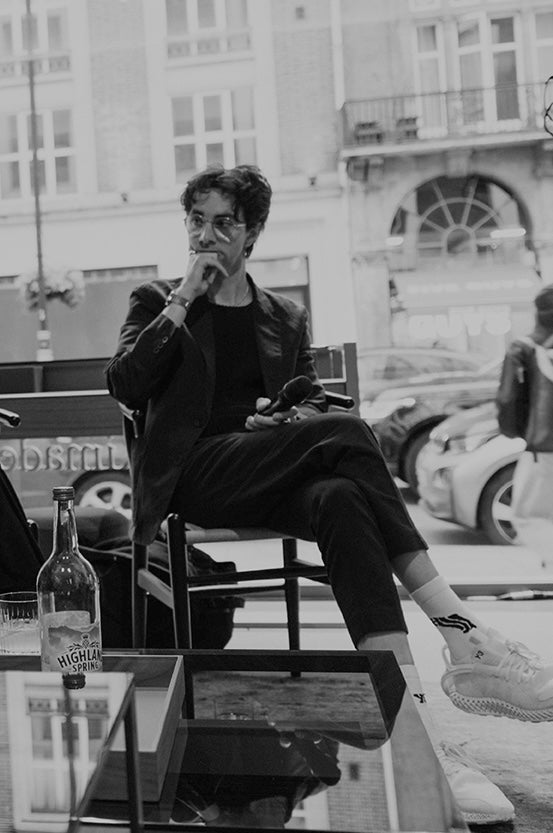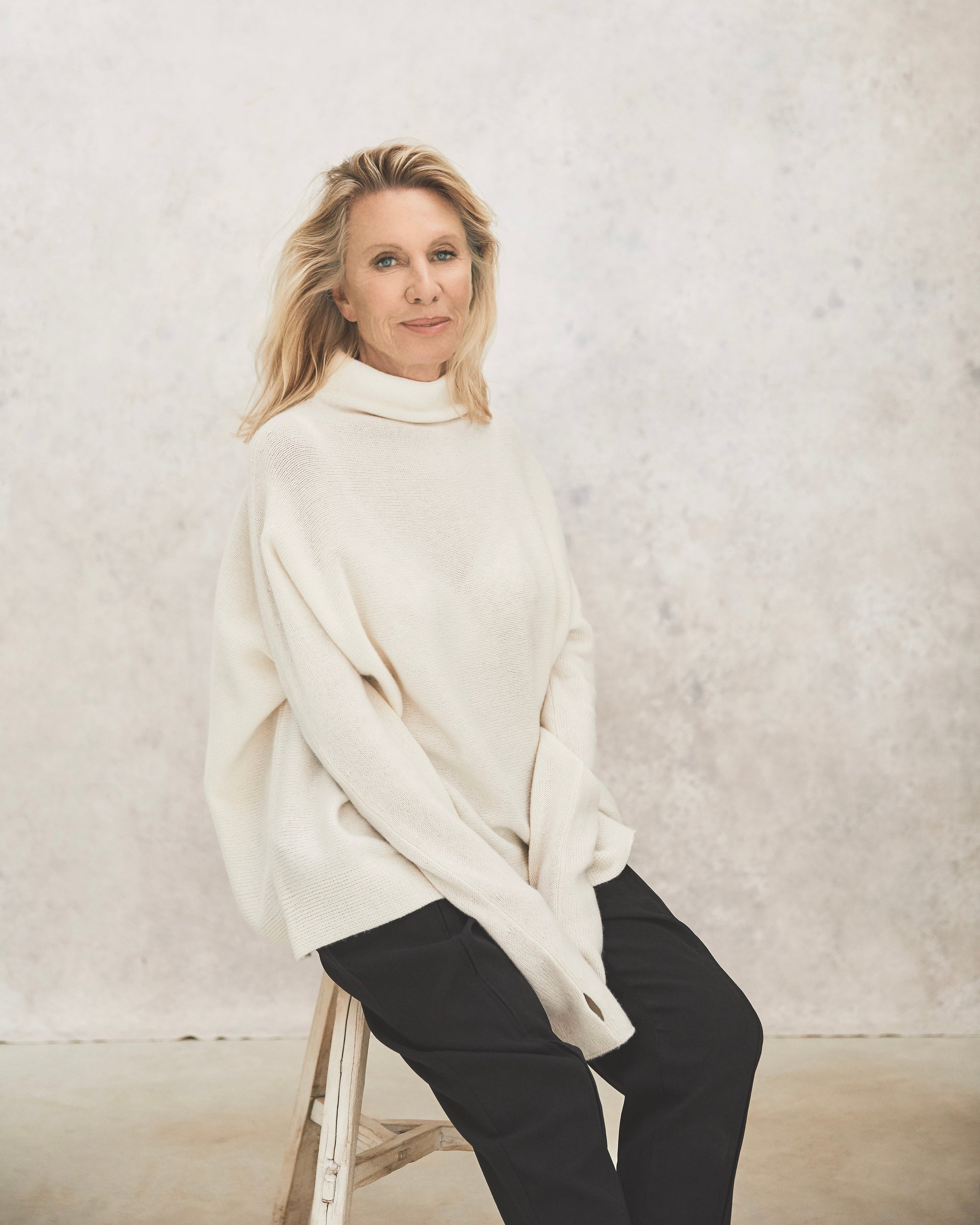Alexie Sommer is never satisfied with dead-end answers regarding practices that harm the planet. Conclusions such as ‘it just does’ and ‘that’s the way we’ve always done it’ fail to convince her. Alexie is sustainability strategist, communication designer, and mentor. Having over 20 years of experience, Sommer has well-established herself within the community of those driving sustainable change. Within her practice, she works at the intersection between design creativity, business sustainability and authentic communication, delivering data-led transformation. Cross-discipline and sector collaboration and research with product, fashion, engineering and architectural design, helps Alexie stay up to date about climate impact and keep it at the forefront of her practice.
Alexie is recognised as a ‘Design for Planet’ expert by The Design Council, demonstrating how dedicated she is to respond to the climate crisis, while simultaneously enabling and encouraging sustainable creation. Sommer has previously held numerous positions within her field, such as design director for creative at The Guardian and The Observer newspaper group and creative director at Thomas Matthews, previously part of the Useful Simple design group. She credits these experiences as being fundamental in shaping her understanding of how to implement positive impact in all of her projects. She is currently co-instigator and communication design lead at Design Declares, and co-founder of Urge Collective.
Q1. How does sustainability influence your work and daily life?
It’s a real driver for how I show up in the world, both personally and professionally. It’s the reason why Urge Collective and Design Declares exist - from a shared vision that sustainability is essential.
Since childhood I have had an awe of the natural world. This consciousness wasn’t labeled ‘sustainability’ then. It was only once I had finished my studies at the Royal College of Art and started exploring the working world that I was aware that sustainability was a thing. Even then, ‘sustainable design’ didn’t really exist. Yes, people were doing it - like long time collaborator and friend Sophie Thomas - but it wasn’t acknowledged back then. Sustainability has only really come centre stage, out of urgency, over the last 10 years.
Today it encourages me to research – it goes with my curiosity to ask simple (often silly!) questions – never satisfied with the “It just does!” or “That’s the way we’ve always done it!” or the “Oooo… I’m not sure about doing it like that!” response. It inspires me to find, wherever reasonably possible, the ‘best’ solution that will have the least negative impact on the planet and the people linked to it.
As an example of how it influences me in my daily life: the question “how do I reduce waste at home?” has led me to buy local, unpackaged food directly from farmers and producers or via local collectives or bulk stores - the quality of the products are often better and it’s worth the extra effort to find the suppliers and bring your own reusable packaging. I try to live by my values whenever I can, jumping on my bike rather than in the car, buying vintage clothes rather than new, mending things if they’re broken, popping on a jumper rather than the heating. These things sound simple and potentially frugal, and it always requires a bit more effort, but it’s worth it.
In my work I’m always asking tricky questions to help find the most sustainable solution. For example, in a recent piece of research for the V&A we asked “What is the impact of reusing an exhibition wall rather than building from new each time?” As it turns out, when you scratch the surface you see it’s a big reduction in waste, virgin materials and carbon emissions. So it’s worth asking the questions, doing the research and then finding a way to implement the insights.
Q2. Have you experienced any pivotal moments that deepened your understanding or commitment to sustainability?
Growing up in Jeddah, Saudi Arabia and travelling to the Red Sea and in the desert instilled a love of adventures in nature and a fascination with different cultures. Travels to Ladakh in the Himalayas when I was 18, and to the Amazon rainforest when I was 27 embedded an awe and respect for the natural world.
Working as Design Director at The Guardian newspaper group from 2008 and then as Creative Director at Thomas Matthews from 2012 deepened my understanding about the business of sustainability, and desire to research and implement a positive impact in all my projects.
The transformative effect of becoming a mother in 2014 really shifted my perspective and fueled my desire to create a better future.
The 2020 pandemic gave me an incredible opportunity to stop the treadmill and start growing vegetables at home. My personal exploration into permaculture began – I created permaculture beds, nurtured the soil with nutrients, finally got to use the compost I’d been stock-piling for a few years, and the results were incredible. Soil is Life.

Q3. Have you encountered any unexpected benefits or opportunities from adopting sustainable practices?
For me, one of the essentials of sustainable practice is connecting more with nature, by spending time in nature and observing natural systems. The benefits of this are huge - a simple walk on the beach or in the forest or a dip in the sea really changes your day for the better.
Opportunities present themselves all the time. Working in sustainability and talking about the work we do has led me to collaborate with like-minded people and explore new cities and countries. For example: the ‘Climate + Culture’ collaboration I facilitated with Art Jameel in Dubai in 2023, connected me with Daniel H Rey, cultural curator who is now based in Madrid, and last month I visited the Madrid Design festival where we hosted a D! meet-up.
I am also constantly inspired by the vision, ambition and positivity of teams I work with at Urge Collective, Design Declares and Constructivist.
Q4. In your view, what’s one simple and doable lifestyle change that could have a meaningful impact on sustainability?
Taking cold showers.
Honestly, it’s incredible how such a simple action can:
- reduce water consumption and energy bills
- make you feel amazing and invigorated in the morning
- boost your immune system
It’s a win win win. I started cold water swimming over 3 years ago, and to help acclimatise my body, started taking cold showers, and I’ve never looked back. Just avoid it when you’re feeling depleted! You can overdo cold showers too ;-)
Q5. How do you think circular economy principles — eliminate waste and pollution, circulate products and materials, and support ecosystem regeneration — could be adopted in your industry or in a hobby?
By working with what already exists i.e. materials, objects, structures that have been salvaged, or would otherwise go to waste and designing with end of life in mind.
Working with reclaimed materials requires: the imagination to create something new; the time to research and find and transform materials; a certain serendipity that the right thing exists exactly when you want and need it; the space to store materials for when you’re ready for them; and the perseverance to hold a circular vision as it’s often easier to create from virgin materials.
I’m currently trying to apply these principles to make a mezzanine bed for my son and honestly it’s not that easy! …the process also requires encouraging others to come on the journey with you - but we’ll get there!
Q6. Are there any books, documentaries, or podcasts around sustainability that you feel particularly inspired by and would recommend to others?
Cradle to Cradle by Michael Braungart - still relevant.
The Carbon Almanac and How Bad are Bananas are full of great info about climate change and carbon emissions.
Flourish by Sarah Ichioka and Micheal Pawlyn - full of brilliant regenerative examples.
Thinking in Systems by Donella Meadows - an essential classic.
Bottlemen Documentary by Nemanja Vojinović is a must see to understand how much crap we produce globally and how important education is.
Rave on for the Avon - a truly heart warming documentary about a Bristol community rallying against pollution.
Jon Richardson and the Futurenauts, is a funny and intelligent lad humour podcast - often makes me lol.
“You never change things by fighting the existing reality. To change something, build a new model that makes the existing model obsolete.” ― R. Buckminster Fuller

Q7. Is there a circular designer or brand you particularly admire and why? This doesn’t have to be in fashion.
Being truly circular is such a huge challenge and there are a few designers I admire whom are pushing the boundaries on circularity:
Sophie Thomas and the projects she’s guiding via Etsaw the circular venture studio such as Marinatex.
I love what Jo Barnard and the team at Morrama have done with Kibu - the circular customizable kids headphones that align with circulatory principles.
And the work that Joel de Mowbray and team at Yes Make are doing in circular construction working with reclaimed materials and building with, and for communities in London.
Q8. What is the most timeless piece in your wardrobe, where did you find it and how long have you had it for?
It’s got to be a pair of black woollen trousers my mum wore in the swinging 60s in London. She handed them down to me about 20 years ago and they still hold their style and shape - they’re a total wardrobe staple and at some point I’ll hand them on.
Q9. What do you consider when buying new clothing?
I try not to buy new. I love vintage and when I have the time I love getting the sewing machine out to adapt clothes I’ve found so that they fit just right.
Vinted is a total guilty pleasure. I’ve found some real gems there, and I often buy stuff for my son because he is growing out of clothes so quickly! Although, with Vinted, I am a little concerned at how people unnecessarily over-package stuff to go in the post….” does it really need half a roll of gaffer tape?” ;-) and Vinted does mean lots of clothes are now travelling around the world and back again if they don’t fit!
When I do buy new, I like to have a connection with the designer or the concepts that are being communicated through the brand.
I love buying stuff designed by fashion designer friends Joanna Sykes, Zakee Shariff, Zoe Lee, Anna Laub and Bernice Pan. I recently brought an amazing coat from Bernice’s brand Deploy that I’ve nicknamed the ‘throw on anytime and look chic’ item. Deploy are impressive with the way they’ve thought through their collections and their dedication to understanding the impact of what they create. They’ve achieved one of the top 10 B-corp scores globally - which is no mean feat for a small brand! Hats off to Deploy - their clothes are worth investing in.
Q10. How do you curate your wardrobe?
It’s a mixture of gifts, hand me downs, vintage, and rare purchases.
A total mix and match of loved items that I’ll always try and hold on to and ‘new second-hand’ clothes that come and go. Textures and fabrics are important - I like clothes that feel good on the skin.
Loving light colours at the moment and finding tonal combinations with a street chic look. Sometimes I’ll go for black and white contrast if I want to feel sharp and serious or poppy colour opposites to lift the spirit.
It really depends on the mood of the day ;-)


